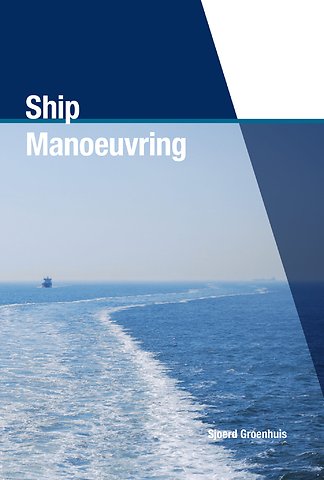

Sjoerd Groenhuis (master marine ocean going, MSc) begon zijn carrière als nautisch officier bij de koopvaardij op stukgoederen- en olietankers.
Meer over Sjoerd GroenhuisShip Manoeuvring
Paperback Engels 2018 1e druk 9789492083210Samenvatting
Manoeuvring is a matter of experience: through a lot of practice – sometimes very complex -manoeuvres will be carried out more and more smoothly. Nevertheless, the many actions that have to be taken must be based on theoretical knowledge. This knowledge of kinetics, hydrodynamics and regulations is essential for every seafarer that ever has to manoeuvre a ship.
‘Ship Manoeuvring’ provides the theoretical information, but has managed to link it to day-to-day practice. Matters like anchoring, tug assistance or passing other ships are addressed extensively. Also, subjects like preparing for passage or navigating through traffic separation schemes are dealt with, in clear understandable terms; the text contains many illustrations and is peppered with technical jargon.
Trefwoorden
scheepvaart manoeuvreren zeevaart maritieme praktijk zeevervoer scheepsbesturing navigatie schepen nautische vaardigheden maritieme veiligheid ankeren zeemanschap manoeuvreereigenschappen zeeschepen meren sleepbootassistentie aanmeren manoeuvreermiddelen hydrodynamica ondiep water voortstuwing scheepsinteractie sleepboten roer schroef loodsladder draaicirkel krachtenleer koersstabiliteit maritieme wetgeving
Trefwoorden
Specificaties
Lezersrecensies
Inhoudsopgave
U kunt van deze inhoudsopgave een PDF downloaden
Introduction
Part 1 Theoretical introduction
1. Key terms at operational level
1.1 Forces working on ships
1.2 Fluid mechanics
1.3 Operational aspects of propellers
1.4 Operational aspects of rudders
1.5 Hull resistance
1.6 Ships’ movements, definitions
2. Key terms at management level
2.1 Propeller-rudder-hull interaction
2.2 Ships’ turning points
Part 2 Operational level
3. Manoeuvrability
3.1 The turning circle
3.2 Stopping distance
3.3 Course stability
Turning moment on ships
4. External influences on manoeuvrability
4.1 Influences of wind and current
4.2 The effects of shallow waters
4.3 Bank effects
5. The anchoring gear
5.1 Anchors’ holding power
5.2 Preparing the anchor
5.3 Procedure for lowering the anchor
5.4 Deep water anchoring
5.5 Going anchor up
5.6 Making the anchoring gear ready for sea
6. The mooring gear
6.1 General
6.2 Types of lines and their use
6.3 Lines’ names and functions
6.4 Safety aspects
6.5 Forces on lines and mooring gear at various angles of incidence
6.6 Making the mooring gear ready for sea
6.7 Testing the winches’ band brake
6.8 Loss of pull on the winch
7. The pilot’s ladder
7.1 Requirements for pilot’s ladders
7.2 Procedure for taking pilots on board
8. Man overboard
8.1 General
8.2 Procedure
Part 3 Management level
9. Passage planning
9.1 The importance of planning
9.2 Making the ship ready to manoeuvre before departure
9.3 Ship’s preparation for calling at a pilot station
9.4 Approaching the pilot station
9.5 Taking the pilot on board
10. Manoeuvring in river mouths, rivers and confined waters
10.1 Safe speeds
10.2 Choice of course
10.3 Manoeuvring round bends
10.4 Turning around in narrow channels
10.5 Navigating narrow channels with tug assistance
11. Turning techniques
11.1 Determining the turning circle and the wheel-over point
11.2 Method of constant rotation
11.3 Monitoring the course when turning
11.3.1 Planning turns when current is present
11.3.2 Calculating distance D with current present
12. Manoeuvring in shallow waters
12.1 General
12.2 Increasing a turning circle
12.3 Changes to course stability
12.4 Stopping distances in shallow waters
12.5 Increase in draught (squat)
12.6 Increased draught due to rolling and pitching
13. Ship-ship interaction
13.1 Ships passing in opposite directions
13.2 Overtaking ships
13.3 Small ships overtaking
14. The use of means of manoeuvring
14.1 Possibilities and limitations of various types of rudder
14.2 Manoeuvring ships with a single propeller
14.3 Manoeuvring ships with twin propellers
14.4 Manoeuvring with azimuth propulsion
14.4.1 Forces at work when using azimuth systems
15. Mooring and unmooring
15.1 Mooring and unmooring using conventional means of manoeuvring
15.2 Mooring and unmooring with twin propellers
15.3 Mooring and unmooring using azimuth propulsion
15.4 Mooring and unmooring with the aid of tugs
15.5 Dry docking
16. Tugboat assistance
16.1 General
16.2 Conventional tugs
16.3 Tractor tugs
16.4 Azimuth Stern Drive
16.4.1 Forces at work on a conventional bow tug
16.4.2 Forces at work on an ASD stern tug
16.4.3 Donkey behaviour
17. Anchoring
17.1 Planning
17.2 Execution
17.3 Controlling drift and ground speed
17.4 Anchoring with two anchors
17.5 Clearing the anchors
18. Manoeuvring in adverse weather conditions
18.1 General
18.2 Measures to take in heavy seas
18.3 Emergency manoeuvres
19. Coming to the aid of other ships or planes in distress
19.1 General
19.2 Picking up drowning victims
20. Manoeuvring in polar regions
20.1 General
20.2 Terminology of the various types of ice
20.3 Ships’ ice classification
20.4 Information on board
20.5 General points of consideration
20.6 Manoeuvring through ice without an icebreaker
20.7 Loss of stability
21. Navigation in traffic separation schemes
21.1 General
21.2 Choice of trajectory
Register
References
Rubrieken
- advisering
- algemeen management
- coaching en trainen
- communicatie en media
- economie
- financieel management
- inkoop en logistiek
- internet en social media
- it-management / ict
- juridisch
- leiderschap
- marketing
- mens en maatschappij
- non-profit
- ondernemen
- organisatiekunde
- personal finance
- personeelsmanagement
- persoonlijke effectiviteit
- projectmanagement
- psychologie
- reclame en verkoop
- strategisch management
- verandermanagement
- werk en loopbaan